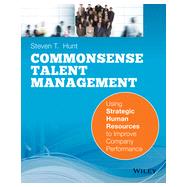A comprehensive guide to using strategic HR methods to increase company performance. This book explains what strategic human resources means, how it differs from other HR activities, and why it is critical to business performance. It walks through key questions for designing, deploying and integrating different strategic HR processes including staffing, performance management, compensation, succession management, and development. The book also addresses the role of technology in strategic HR, and discusses how to get companies to support, adopt, and maintain effective strategic HR processes. The book includes dozens of illustrative examples of effective and ineffective strategic HR using stories drawn from a range of companies and industries.

Common Sense Talent Management Using Strategic Human Resources to Improve Company Performance
by Hunt, Steven T.-

Free Shipping on All Orders!
*excludes Marketplace items.
Buy New
Buy Used
Rent Book
Rent Digital
How Marketplace Works:
- This item is offered by an independent seller and not shipped from our warehouse
- Item details like edition and cover design may differ from our description; see seller's comments before ordering.
- Sellers much confirm and ship within two business days; otherwise, the order will be cancelled and refunded.
- Marketplace purchases cannot be returned to eCampus.com. Contact the seller directly for inquiries; if no response within two days, contact customer service.
- Additional shipping costs apply to Marketplace purchases. Review shipping costs at checkout.
Summary
Author Biography
Table of Contents
Author’s Foreword
Chapter 1. Introduction
1.1 How the book is structured
1.2 The role of HR technology in strategic HR
1.3 Why this book matters
Sidebars
Chapter 2. Strategic HR: what it is, why it is important and why it is often difficult
2.1 The fundamental processes of Strategic HR
2.2 Why do we need strategic HR?
2.3 What makes strategic HR difficult?
Sidebars
Chapter 3. Business Execution and strategic HR
3.1 Defining business execution
3.2 Assessing Business Execution Needs
3.3 Using Strategic HR processes to support business execution
3.4 Linking specific business execution drivers to different HR processes
3.5 Increasing strategic HR process maturity
3.6 Integrating strategic HR processes.
3.7 Conclusion: summarizing how to use strategic HR processes to drive business execution
Sidebars
Chapter 4. Right people: designing recruiting and staffing processes
4.1 Recruiting to Support Business Execution
4.2 Critical recruiting design questions
4.3 Recruiting Process Maturity
4.4 Conclusion
Sidebars
Chapter 5. Doing the Right Things: becoming a goal driven organization
5.1 Becoming a “goal driven” organization
5.2 The role of goals in an integrated strategic HR system
5.3 Goal Management Critical Design Questions
5.4 Goal Management Process Maturity
5.5 Conclusion
Table 5.1. Some simple goal setting guidelines
Table 5.2 Commitment, Outcome, Deliverable Goal Methodology
Sidebars
Chapter 6. Doing things the right way: Using performance management to increase business execution
6.1 Why is performance management so difficult?
6.2 Why do we need performance management?
6.3 Balancing the conflicting goals of performance management
6.4 Critical performance management design questions
6.5. Increasing performance management process maturity.
6.6 Conclusion
Sidebars
Chapter 7: Creating the right development experiences
7.1 The basic components of a development process
7.2. The six primary development methods
7.3. Approaching development programs from an integrated perspective
7.4 Critical development design questions
7.5. Increasing development process maturity.
7.6 Conclusion
Sidebars
Chapter 8: Creating an integrated HR strategy
8.1 Identifying the change you want to create
8.2 Defining what the change will look like
8.3 Defining how you will create and measure the change.
8.4 Operationalizing the change.
8.5 Conclusion
Sidebars
Chapter 9: Strategic HR Process Deployment and Adoption
9.1 Establishing HR Leadership Credibility
9.2 Defining the change and change requirements
9.3 Providing tools and knowledge to support the change
9.4 Enlisting line leadership support
9.5 Conclusion
Sidebars
Chapter 10: Summary and call for action
Appendices
Appendix 1. A comprehensive library of behavioral competencies
GLOSSARY
Index
An electronic version of this book is available through VitalSource.
This book is viewable on PC, Mac, iPhone, iPad, iPod Touch, and most smartphones.
By purchasing, you will be able to view this book online, as well as download it, for the chosen number of days.
Digital License
You are licensing a digital product for a set duration. Durations are set forth in the product description, with "Lifetime" typically meaning five (5) years of online access and permanent download to a supported device. All licenses are non-transferable.
More details can be found here.
A downloadable version of this book is available through the eCampus Reader or compatible Adobe readers.
Applications are available on iOS, Android, PC, Mac, and Windows Mobile platforms.
Please view the compatibility matrix prior to purchase.
